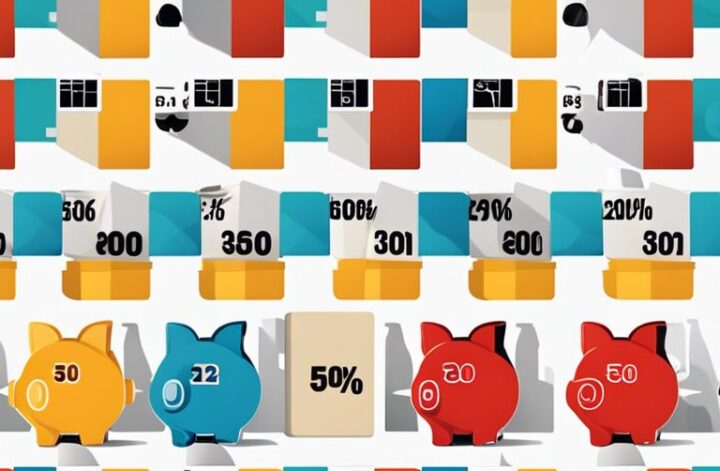Rule is crucial in maintaining financial stability and achieving long-term goals. One popular method that provides a clear framework for managing your money wisely is the 50/30/20 rule. This simple yet effective budgeting strategy involves dividing your after-tax income into three categories: 50% for needs, 30% for wants, and 20% for savings and debt repayment. By following this guideline, individuals can ensure they are prioritizing imperative expenses, enjoying some discretionary spending, and building a financial cushion for the future.
Key Takeaways:
- Save 50% for Needs: Allocate 50% of your income towards necessary expenses such as rent, utilities, groceries, and insurance.
- Allocate 30% for Wants: Reserve 30% of your income for non-necessary expenses like dining out, entertainment, travel, and shopping.
- Save 20% for Savings and Debt Repayment: Dedicate 20% of your income towards saving for the future and paying off any outstanding debts.
- Consistent Budgeting: Implementing the 50/30/20 rule helps maintain a balanced budget by prioritizing savings while allowing for discretionary spending.
- Flexibility and Adaptability: Be willing to adjust your budget as needed based on changes in income, expenses, or financial goals to ensure long-term financial stability.
The Fundamentals of the 50/30/20 Rule
Origin and Popularity
Rule of thumb, the 50/30/20 rule has gained popularity as a straightforward and effective budgeting strategy for managing personal finances. Originating from the book “All Your Worth: The Ultimate Lifetime Money Plan” by Elizabeth Warren and Amelia Warren Tyagi, this rule suggests dividing your after-tax income into three broad categories – 50% for needs, 30% for wants, and 20% for savings and debt repayment. The simplicity and practicality of this rule make it an attractive option for individuals looking to allocate their income effectively.
How the Rule Works
An effective way to apply the 50/30/20 rule is by first calculating your monthly after-tax income. From there, allocate 50% of that amount towards imperative needs such as housing, utilities, groceries, and transportation. The next 30% can be earmarked for discretionary spending on wants like dining out, entertainment, and shopping. The remaining 20% should be directed towards savings, investments, and paying off any outstanding debts. This structured approach not only helps in ensuring that your basic needs are met but also encourages saving for the future.
Breaking Down the 50/30/20 Rule
Allocating 50% to Needs
Clearly, allocating 50% of your income towards your needs is crucial for ensuring financial stability. This includes expenses such as rent or mortgage, utilities, groceries, transportation, and other importants. By adhering to this allocation, you can cover your basic living costs effectively and avoid financial strain.
Allocating 30% to Wants
For those wondering about how to allocate the remaining 30% of their income to wants, it is important to remember that these are non-important expenditures that add value to your life. This category may include dining out, entertainment, travel, and other indulgences that bring you joy and fulfillment.
An additional point to consider for this 30% allocation to wants is the importance of balancing indulgence with responsibility. While enjoying life is vital, it is equally crucial to prioritize needs and long-term financial stability.
Allocating 20% to Savings
Definition: Allocating 20% of your income to savings is a key component of the 50/30/20 rule. This portion should be dedicated to building an emergency fund, contributing to retirement accounts, and achieving other financial goals. Savings are crucial for creating financial security and ensuring a stable future.
Allocating a significant portion of your income to savings not only helps you meet unexpected expenses but also allows you to work towards long-term financial objectives, such as buying a house or retiring comfortably. Prioritizing savings as per the 50/30/20 rule is a prudent strategy for achieving financial well-being and peace of mind.
Benefits of the 50/30/20 Rule
Despite the myriad of budgeting strategies available, the 50/30/20 rule stands out as a simple yet powerful method for managing finances effectively. For those unfamiliar with this rule, you can learn more about it by reading this detailed guide on What Is The 50/30/20 Rule?
Simplicity and Ease of Use
Any individual, regardless of their financial knowledge, can easily grasp and implement the 50/30/20 rule. By allocating 50% of your income towards needs, 30% towards wants, and 20% towards savings and debt repayment, this rule simplifies the budgeting process. This straightforward breakdown helps individuals maintain a balanced financial lifestyle without the need for complex calculations or extensive budgeting tools.
Flexibility and Adaptability
On top of its simplicity, the 50/30/20 rule offers a level of flexibility that accommodates various income levels and lifestyles. Whether you are a high-income earner or just starting out, this rule can be tailored to suit your specific financial situation. For instance, as your income fluctuates over time, you can easily adjust your allocations within the 50/30/20 framework to meet your evolving needs and goals.
Another key advantage of this rule is its adaptability to different financial priorities. While the percentages allocate funds to different categories, the specific expenses within each category can be customized based on individual circumstances. This adaptability allows for personalized budgeting while ensuring a consistent focus on savings and debt reduction.

Challenges and Considerations
Keep What is the 50/30/20 budget rule, and is it right for you? in mind as you implement the 50/30/20 rule in your budgeting strategy. While this framework proves beneficial for many, some individuals may face challenges in adhering to it due to certain factors.
High-Cost of Living Areas
The high cost of living in certain areas can pose a challenge when trying to allocate 50% of your income to needs. In such regions, housing prices, utility costs, and other necessarys may take up a significant portion of your budget, leaving less room for wants and savings. Individuals residing in these areas may need to make adjustments to ensure they strike a balance between the three categories effectively.
Irregular Income Streams
An irregular income stream can complicate the application of the 50/30/20 rule. Individuals with fluctuating or inconsistent earnings may find it challenging to allocate a fixed percentage to each category every month. In such cases, it becomes crucial to exercise flexibility and adaptability in budgeting to accommodate the variability in income levels.
With careful planning and thoughtful adjustments, individuals can overcome these challenges and effectively implement the 50/30/20 rule to manage their finances successfully. Flexibility and mindfulness play key roles in navigating through potential obstacles and ensuring a balanced allocation of income towards savings, needs, and wants.

Implementing the 50/30/20 Rule in Your Financial Plan
Tracking Your Income and Expenses
Many people struggle with managing their finances effectively, often not knowing where their money is going. One way to gain control over your financial situation is to track your income and expenses diligently. By keeping a record of how much money you are bringing in each month and where it is being spent, you can get a clear picture of your financial habits. This information is crucial for implementing the 50/30/20 rule successfully.
Adjusting the Rule to Suit Your Financial Situation
Suiting the 50/30/20 rule to your specific financial circumstances is necessary for achieving financial stability. While the general guideline recommends allocating 50% of your income to needs, 30% to wants, and 20% to savings, it may not work for everyone. For example, if you have high student loan payments or medical expenses, you may need to adjust the percentages accordingly. The key is finding a balance that works for you and helps you reach your financial goals.
Rule: There are many tools and apps available to help you implement the 50/30/20 rule effectively. These tools can assist you in tracking your expenses, setting budgeting goals, and monitoring your progress. By utilizing technology, you can automate certain aspects of your financial plan and stay on top of your budget effortlessly.
Tools and Apps to Help Implement the Rule
Expenses: One popular app that can aid you in following the 50/30/20 rule is Mint, which connects to your bank accounts and categorizes your transactions for you. This makes it easier to see where your money is going and how you can adjust your spending habits to align with the rule. Additionally, budgeting tools like EveryDollar or YNAB can help you create a detailed budget and track your progress towards your savings goals.
Advanced Tips for Optimizing Your 50/30/20 Budget
To further enhance your budgeting skills and make the most out of the 50/30/20 rule, consider these advanced tips:
Reducing Expenses in the Needs Category
Any successful budget relies on effectively managing your needs category, which includes vital expenses like rent, groceries, and utilities. To reduce costs in this category, consider negotiating bills, cutting unnecessary subscriptions, or meal planning to minimize food expenses. Prioritizing needs over wants is crucial to maintain financial stability.
Prioritizing Financial Goals in the Savings Category
Prioritizing savings is key to achieving long-term financial stability. Start by setting specific goals, such as building an emergency fund or saving for retirement. Automate your savings by setting up regular transfers to a dedicated savings account to ensure consistency. Recall, every bit saved adds up over time to secure your financial future.
Reducing expenses in the needs category and prioritizing financial goals in the savings category are vital steps to optimize your 50/30/20 budget effectively. By making conscious decisions and staying committed to your financial objectives, you can achieve a healthy balance between meeting your needs and saving for the future.
Finding the Right Balance for Your Wants
Rightly balancing your wants category is a delicate process that requires mindful consideration. While it’s vital to enjoy life and indulge in occasional treats, it’s equally crucial not to overspend on non-vitals. Take the time to differentiate between true desires and impulsive purchases to maintain a healthy financial outlook.
Savings are the cornerstone of financial security, and allocating 20% of your income toward savings each month can pave the way for a robust financial future. By consistently prioritizing savings goals and making smart spending decisions, you can achieve your financial milestones and enjoy peace of mind knowing you’re on the right track.

Summing up
Conclusively, the 50/30/20 rule is a straightforward yet powerful budgeting strategy that can help individuals effectively allocate their income for savings, needs, and wants. By following this rule, individuals can prioritize saving for the future, covering their necessary expenses, and indulging in discretionary spending without going overboard. This approach not only promotes financial stability and security but also instills a sense of discipline and control over one’s finances.
Overall, implementing the 50/30/20 rule can lead to a more balanced and mindful approach to managing money. By categorizing income into savings, needs, and wants, individuals can make informed decisions about where their money goes, ensuring that they are not only meeting their immediate financial obligations but also building a secure financial future. So, whether you are just starting on your budgeting journey or looking to refine your existing financial plan, give the 50/30/20 rule a try and see the positive impact it can have on your financial well-being.



